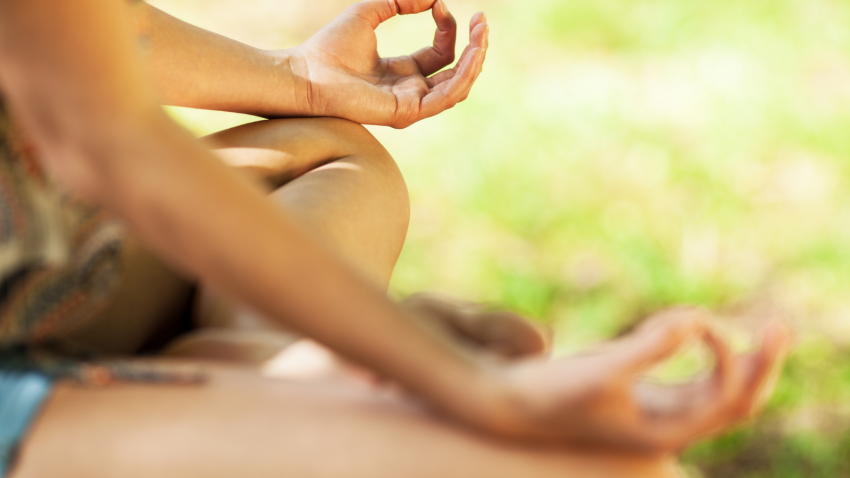View basket (0 items $0.00)
Error message
- Notice: unserialize(): Error at offset 5 of 154 bytes in variable_initialize() (line 1202 of /home/dh_6hcdc2/yogau.online/docroot/includes/bootstrap.inc).
- The file could not be created.
- The file could not be created.

Profound Benefits of Yoga’s Mudras
The word mudra is most often used to describe a particular hand gesture, but there are also face mudras and whole-body mudras. According to the yoga tradition, mudras have multiple layers of meaning, including neurological, energetic, psychological, and symbolic. My last post described the neurological layer. Today let’s take a look at the other layers.
How Yoga’s Mudras Affect the Energetic Layer
Yoga’s mudras are often used as a way to direct energy throughout the body. According to the yoga tradition, our vital energy (prana) that is produced and carried throughout the body, escapes the body through the fingers and then dissipates into the external world. By folding our fingers into certain shapes, we create energetic circuits that redirect the energy back into the body and facilitate the states of interoception (awareness of inner sensations), introspection, and concentration.
Specific hand gestures are also meant to balance out more subtle aspects of our energetic anatomy, including Nadis (energy channels), vayus (energy currents), and chakras (energetic centers) to facilitate the health and healing of different layers of our physiological systems.
 Whole-body mudras, like Maha Mudra, for example, are meant to direct the energy flow along the primary energetic channel of the body—the spine. When we fold the body into this mudra, we work on bringing the spine into maximum vertical alignment to ensure unimpeded energy flow; then we use breath and awareness to move the energy along the spine.
Whole-body mudras, like Maha Mudra, for example, are meant to direct the energy flow along the primary energetic channel of the body—the spine. When we fold the body into this mudra, we work on bringing the spine into maximum vertical alignment to ensure unimpeded energy flow; then we use breath and awareness to move the energy along the spine.
How Yoga’s Mudras Affect the Psychological Layer
Mudras are meant to evoke certain mental states. Similar to affirmations, yoga’s mudras bring our attention to certain qualities and states that we wish to cultivate within ourselves. As part of survival strategy, our brains had developed a “negativity bias,” which means that we are much more likely to believe negative things about ourselves and our reality.
It takes conscious effort to bring our attention to what’s good in our lives and reaffirm what we really want, rather than continuously focus on the things we are afraid of. We can manifest positive qualities like receptivity, self-empowerment, centering, and so on, by attempting to embody them and then “sealing” them with a corresponding hand gesture. This way we can retrain our brains and release our limiting beliefs.
How Yoga’s Mudras Affect the Symbolic Layer

In different traditions, five fingers of each hand are symbolically associated with specific elements, chakras, meridians, and planets. Parts of the hands are linked to various acupressure points and reflex zones. Applying light pressure to specific spots on the hand and folding our fingers a certain way is meant to help us regulate the qualities of a particular element, chakra, and so on.
In yoga, mudras are widely used as part of a spiritual practice to awaken particular spiritual states and qualities. One mudra or a combination of yoga’s mudras can be used as part of a ritual to help us enter a meditative state and connect to something greater than ourselves.
Reprinted with permission from Sequence Wiz.
 Educated as a school teacher, Olga Kabel has been teaching yoga for over 14 years. She completed multiple Yoga Teacher Training Programs but discovered the strongest connection to the Krishnamacharya/ T.K.V. Desikachar lineage. She had studied with Gary Kraftsow and American Viniyoga Institute (2004-2006) and received her Viniyoga Teacher diploma in July 2006, becoming an AVI-certified Yoga Therapist in April 2011. Olga is a founder and managing director of Sequence Wiz-a web-based yoga sequence builder that assists yoga teachers and yoga therapists in creating and organizing yoga practices. It also features simple, informational articles on how to sequence yoga practices for maximum effectiveness. Olga strongly believes in the healing power of this ancient discipline on every level: physical, psychological, and spiritual. She strives to make yoga practices accessible to students of any age, physical ability, and medical history, specializing in helping her students relieve muscle aches and pains, manage stress and anxiety, and develop mental focus.
Educated as a school teacher, Olga Kabel has been teaching yoga for over 14 years. She completed multiple Yoga Teacher Training Programs but discovered the strongest connection to the Krishnamacharya/ T.K.V. Desikachar lineage. She had studied with Gary Kraftsow and American Viniyoga Institute (2004-2006) and received her Viniyoga Teacher diploma in July 2006, becoming an AVI-certified Yoga Therapist in April 2011. Olga is a founder and managing director of Sequence Wiz-a web-based yoga sequence builder that assists yoga teachers and yoga therapists in creating and organizing yoga practices. It also features simple, informational articles on how to sequence yoga practices for maximum effectiveness. Olga strongly believes in the healing power of this ancient discipline on every level: physical, psychological, and spiritual. She strives to make yoga practices accessible to students of any age, physical ability, and medical history, specializing in helping her students relieve muscle aches and pains, manage stress and anxiety, and develop mental focus.
Featured Courses









